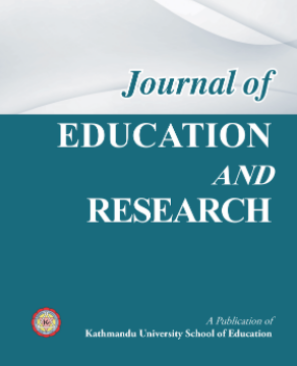
Opportunities for Multi-Lingual Education in Nepal
Original Article
Journal of Education and Research, Volume 2, Issue 1, 2010, 30-34, https://doi.org/10.3126/jer.v2i0.7620
Publication date: Mar 15, 2010
Views: 411 | Downloads: 248
How to cite this article
APA
In-text citation: (Koirala, 2010)
Reference: Koirala, B. N. (2010). Opportunities for Multi-Lingual Education in Nepal. Journal of Education and Research, 2(1), 30-34. https://doi.org/10.3126/jer.v2i0.7620
Reference: Koirala, B. N. (2010). Opportunities for Multi-Lingual Education in Nepal. Journal of Education and Research, 2(1), 30-34. https://doi.org/10.3126/jer.v2i0.7620
Vancouver
In-text citation: (1), (2), (3), etc.
Reference: Koirala BN. Opportunities for Multi-Lingual Education in Nepal. Journal of Education and Research. 2010;2(1):30-4. https://doi.org/10.3126/jer.v2i0.7620
Reference: Koirala BN. Opportunities for Multi-Lingual Education in Nepal. Journal of Education and Research. 2010;2(1):30-4. https://doi.org/10.3126/jer.v2i0.7620
AMA
In-text citation: (1), (2), (3), etc.
Reference: Koirala BN. Opportunities for Multi-Lingual Education in Nepal. Journal of Education and Research. 2010;2(1), 30-34. https://doi.org/10.3126/jer.v2i0.7620
Reference: Koirala BN. Opportunities for Multi-Lingual Education in Nepal. Journal of Education and Research. 2010;2(1), 30-34. https://doi.org/10.3126/jer.v2i0.7620
Chicago
In-text citation: (Koirala, 2010)
Reference: Koirala, Bidya Nath. "Opportunities for Multi-Lingual Education in Nepal". Journal of Education and Research 2010 2 no. 1 (2010): 30-34. https://doi.org/10.3126/jer.v2i0.7620
Reference: Koirala, Bidya Nath. "Opportunities for Multi-Lingual Education in Nepal". Journal of Education and Research 2010 2 no. 1 (2010): 30-34. https://doi.org/10.3126/jer.v2i0.7620
Harvard
In-text citation: (Koirala, 2010)
Reference: Koirala, B. N. (2010). Opportunities for Multi-Lingual Education in Nepal. Journal of Education and Research, 2(1), pp. 30-34. https://doi.org/10.3126/jer.v2i0.7620
Reference: Koirala, B. N. (2010). Opportunities for Multi-Lingual Education in Nepal. Journal of Education and Research, 2(1), pp. 30-34. https://doi.org/10.3126/jer.v2i0.7620
MLA
In-text citation: (Koirala, 2010)
Reference: Koirala, Bidya Nath "Opportunities for Multi-Lingual Education in Nepal". Journal of Education and Research, vol. 2, no. 1, 2010, pp. 30-34. https://doi.org/10.3126/jer.v2i0.7620
Reference: Koirala, Bidya Nath "Opportunities for Multi-Lingual Education in Nepal". Journal of Education and Research, vol. 2, no. 1, 2010, pp. 30-34. https://doi.org/10.3126/jer.v2i0.7620
ABSTRACT
For decolonizers language is a tool of domination (Awasthi, 2004; Bourdieu, 1977); for language groups it is a subjectivity and inter-subjectivity (Koirala, 2007); for utilitarian it is a vehicle to take people from the local to the global world (Khadka, 2007); for knowledge seekers and promoters it is a means to generate the hidden treasure of the subalterns' wisdom (Guha, 2005); for linguists' it is a way to save language (Khadka et.al., 2006; Khadka, 2007); for activists it is a means to activate people (Yonjan, 2007); for existentialists language is the socio-political, cultural, and linguistic identity (CRED, 2005; Chirag, 2001), and for pedagogues it is a means to made easy and dignified learning (Mallikarjun, 2002). It means language is the response to the situatedness (Leve & Wegner, 1992). To resolve these concerns one needs language of co-existence, reciprocal learning and teaching.
Nepal has more than hundred languages with 15 scripts (Khadka, Magar, & Koirala, 2006; Koirala, Khadka, & Magar, 2008). Muslim children for example should learn at least three scripts together, the Urdu, the Devnagari, and the English. This situation looks for shared script.
Nepal has more than hundred languages with 15 scripts (Khadka, Magar, & Koirala, 2006; Koirala, Khadka, & Magar, 2008). Muslim children for example should learn at least three scripts together, the Urdu, the Devnagari, and the English. This situation looks for shared script.
KEYWORDS
---
REFERENCES
---
LICENSE
This work is licensed under a Creative Commons Attribution 4.0 International License.
